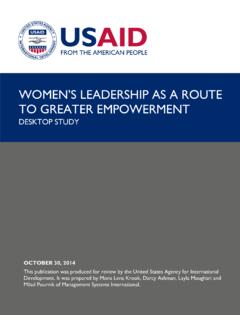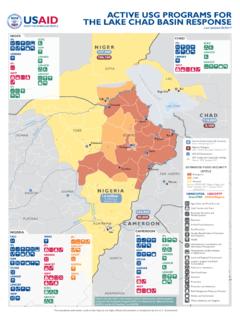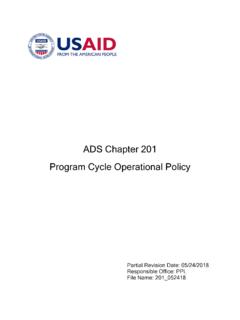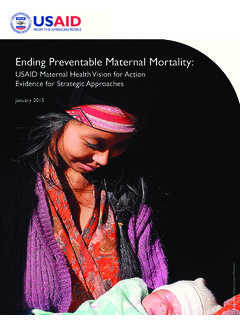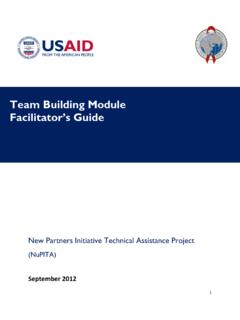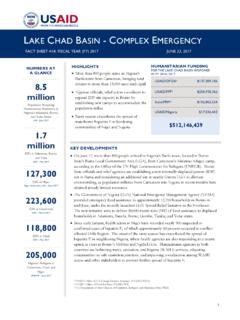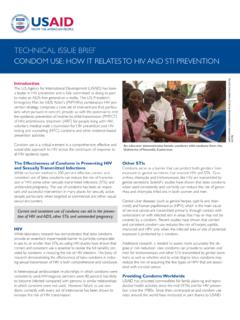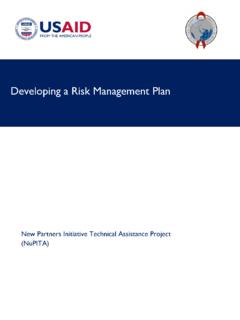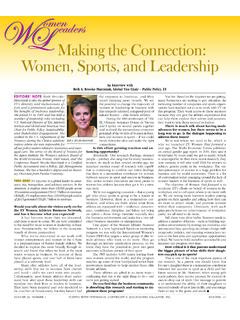Transcription of WOMEN’S LEADERSHIP AS A ROUTE TO GREATER …
1 women S LEADERSHIP AS A ROUTE TO GREATER empowerment KENYA CASE STUDY SEPTEMBER 29, 2014 This publication was produced for review by the United States Agency for International Development. It was prepared by Aili Tripp, Catie Lott and Louise Khabure on behalf of Management Systems International. women S LEADERSHIP AS A ROUTE TO GREATER empowerment KENYA CASE STUDY Management Systems International Corporate Offices 200 12th Street, South Arlington, VA 22202 USA Tel: + 1 703 979 7100 Contracted under IQC No: AID-OAA-I-10-00002, Task Order No. AID-OAA-TO-13-00046 DISCLAIMER The author s views expressed in this publication do not necessarily reflect the views of the United States Agency for International Development or the United States Government. women S LEADERSHIP AS A ROUTE TO GREATER empowerment : KENYA CASE STUDY i CONTENTS ACRONYMS AND ABBREVIATIONS .. II MAP OF KENYA .. III MAP OF KENYA S COUNTIES .. IV I. EXECUTIVE SUMMARY.
2 1 PURPOSE OF 1 CONCEPTUAL FRAMEWORK .. 1 1 INFLUENCES ON women S POLITICAL empowerment .. 2 GATEKEEPERS .. 2 CONSTRAINTS ON women RUNNING FOR OFFICE .. 2 2013 ELECTIONS .. 2 USAID S WORK IN POLITICAL empowerment OF women .. 2 KEY PROBLEMS TO BE ADDRESSED .. 3 RECOMMENDATIONS FOR USAID PROGRAMMING .. 3 II. INTRODUCTION .. 4 III. CONTEXT: KEY ACTORS, INSTITUTIONS, STRUCTURES AND FRAMES .. 5 CONTEXTUAL FACTORS .. 5 OVERALL STATUS OF women IN KENYA .. 5 HISTORY OF MOBILIZATION FOR women S POLITICAL RIGHTS IN KENYA .. 6 INFLUENCES ON women S POLITICAL empowerment .. 9 CONSTRAINTS ON women RUNNING FOR OFFICE .. 17 IV. women S POLITICAL empowerment BENCHMARKS .. 20 INSTITUTIONS AND women S REPRESENTATION .. 20 2013 ELECTION .. 21 women S PRESENCE IN FORMAL POLITICAL STRUCTURES .. 21 LEGISLATIVE LEADERSHIP FOLLOWING THE 2013 ELECTIONS .. 23 JUDICIAL LEADERSHIP .. 24 SECURITY SECTOR LEADERSHIP .. 25 TYPES OF women REPRESENTED IN FORMAL GOVERNMENT.
3 26 FACTORS INFLUENCING women S ADVANCEMENT .. 27 IMPACT OF women ON FORMAL INSTITUTIONS .. 27 SYMBOLIC IMPACTS .. 28 V. USAID PROGRAM RESULTS ASSESSMENT .. 29 NATIONAL DEMOCRATIC 29 INTERNATIONAL REPUBLICAN INSTITUTE .. 30 KEPPS: STRENGTHENING women S PARTICIPATION (2011 2013) .. 30 KEPPS: ENHANCING KENYA S TRANSITIONAL PROCESS (2012 2014) .. 30 CHALLENGES .. 30 VI. USAID PROGRAMMING RECOMMENDATIONS .. 31 MAIN OBJECTIVES .. 31 RECOMMENDATIONS .. 31 VII. INTERVIEWS .. 35 VIII. REFERENCES .. 38 women S LEADERSHIP AS A ROUTE TO GREATER empowerment : KENYA CASE STUDY ii ACRONYMS AND ABBREVIATIONS CBO Community-Based Organization CDCS Country Development Cooperation Strategies CEPPS Consortium for Elections and Political Process Strengthening CKRC Constitution of Kenya Review Commission CMD Centre for Multi-Party Democracy CREAW Center for Rights, Education and Awareness CSO Community Support Organizations DRG Democracy, Human Rights and Governance EPT Elections and Political Transitions FIDA Federation of women Lawyers GBM Kenyan Greenbelt Movement GBV Gender-Based Violence HIV Human Immunodeficiency Virus IEBC Independent Election and Boundaries Commission IFES International Foundation for Electoral System IRI International Republican Institute KANU Kenya Africa National Union KEPPS Kenya Election and Political Processes Strengthening Program KEWOPA Kenya women Parliamentary Association KEWOSA Kenya women Senators Association KWPC Kenya women s Political Caucus M&E Monitoring and Evaluation MCA Member of County Assembly MP Member of Parliament MSI Management Systems International MYWO Maendeleo ya Wanawake NARC National Rainbow Coalition NCWK National Council of women of Kenya NDI National Democratic Institute NGEC National Gender and Equality Commission NGO Non-Governmental Organization ODM Orange Democratic Movement PR
4 Proportional Representation SUNY State University of New York TNA National Alliance UN United Nations USAID United States Agency for International Development WDM Wiper Democratic Movement WPAK women s Political Alliance of Kenya women S LEADERSHIP AS A ROUTE TO GREATER empowerment : KENYA CASE STUDY iii MAP OF KENYA women S LEADERSHIP AS A ROUTE TO GREATER empowerment : KENYA CASE STUDY iv MAP OF KENYA S COUNTIES Source: GeoCurrents women S LEADERSHIP AS A ROUTE TO GREATER empowerment : KENYA CASE STUDY 1 I. EXECUTIVE SUMMARY Purpose of Study This report presents the findings and recommendations of a women s Political empowerment assessment conducted for USAID/Kenya by a team assembled by Management Systems International (MSI). The study is part of a broader global study that will advance understanding of the nature and extent of relevant USAID programs and their contribution to improving women s LEADERSHIP and political empowerment .
5 The purpose of this assessment was to identify major trends and challenges with regard to women s political empowerment in Kenya to inform the design of USAID strategy and programs in this area. This report on Kenya is one of five country case studies selected to provide USAID with a more in-depth assessment of results achieved and complement a desktop study of USAID programming in this area. Conceptual Framework This study is interested in women s political empowerment : how to increase both the presence of women in political LEADERSHIP and their voice and ability to effect policy changes once in office. This is important not only because it is a question of equity and justice, but also because women cannot have their voices, interests and experiences taken into account if they are not present in LEADERSHIP and decision-making bodies. Whether women political leaders have an impact on woman-friendly policy is still being debated, especially because so many other factors, including the role of parties, women s movements, regime type, and backlash movements can also influence outcomes.
6 Much also depends on how one defines women s interests and woman-friendly policies and how one accounts for varied and even conflicting interests among women themselves (Escobar-Lemmon and Taylor Robinson 2014; Franceschet, Krook and Piscopo 2012; Htun and Weldon 2012; Swers 2013). Background The one-party rule of Kenya Africa National Union (KANU), and its patronage-based dominance of women s mobilization through organizations like Maendeleo ya Wanawake (MYWO), kept women s rights activists depoliticized and mainly focused on developmental issues from the time of independence until the early 1990s. The adoption of a multiparty state opened up new possibilities for women s mobilization and advocacy that was autonomous of the state and ruling party. women s organizations became engaged in numerous efforts to promote women s political empowerment , particularly in the constitution-making process. Political unrest after the 2007 elections reinvigorated the process and a new 2010 constitution created the basis for women to claim more than one-third representation in government and all decision-making bodies and state institutions.
7 The struggle after 2010 has been to implement the constitution, particularly in the national parliament and in areas where women have been especially poorly represented, such as the military and police. Recent trends indicate that the need to address women s political empowerment , and empowerment more generally, has never been GREATER . According to the World Economic Forum Gender Gap Index, the status of women has declined in Kenya since the index began measuring the gap in 2006, particularly in the area of economic empowerment . women S LEADERSHIP AS A ROUTE TO GREATER empowerment : KENYA CASE STUDY 2 Influences on women s Political empowerment The key drivers of women s political empowerment have been the women s movement, the Kenya women Parliamentary Association (KEWOPA), UN agencies and donors, but also to some extent political parties, women s policy agencies such as the National Gender Equality Commission and Gender Directorate under the Ministry of Devolution and Planning.
8 The Council of Governors has been an important ally for tactical reasons. Gatekeepers Political parties are the most influential gatekeepers for women in politics. As much as parties have facilitated women s political empowerment , they have also been among the biggest obstacles. They have at times excluded women from competitive nomination processes, which are often rigged, and have withheld support to women , particularly financial support in the case of smaller parties. Other important gatekeepers include the media, Independent Election and Boundaries Commission, Registrar of Parties, elders and religious institutions. Constraints on women Running for Office Violence and Intimidation: Perhaps the single factor that has the most influence on women s political LEADERSHIP is the extensive violence and threat of violence experienced by women political aspirants as well as leaders. The level of violence women experienced in the elections is unparalleled in Africa.
9 Resources: The lack of campaign finance reform is another major constraint on women candidates, who generally have fewer resources and are more likely not to be incumbents, further disadvantaging them. Cultural Constraints: Interview respondents often articulated a deep awareness that patriarchy was at the root of beliefs and practices that stood in the way of women making political gains. 2013 Elections The 2013 elections brought modest gains for women in affirmative action seats. For example, the percentage of women rose in: The Cabinet from percent to 33 percent; The legislature from percent to percent; The county assembly to 52 percent*; The Supreme Court to 29 percent*; The Appeals Court from zero to 31 percent; and The High Court from 40 percent to 49 percent. However, the proportion of women elected to open seats actually declined at the national level in the 2013 elections from 2002 and 2007. (*County assemblies and the Supreme Court did not exist before the new constitution, so there is no starting figure for them.)
10 USAID S Work in Political empowerment of women USAID was involved in crucial efforts to write and implement the 2010 constitution, particularly to include key provisions affecting women . Subsequently, it was involved in a variety of activities leading up to the 2013 elections to train women and promote them as candidates, primarily through its Kenya Election and Political Processes Strengthening Program (KEPPS). women S LEADERSHIP AS A ROUTE TO GREATER empowerment : KENYA CASE STUDY 3 Much of the focus of USAID in the recent past has been on the constitution-making process and then the 2013 elections, ensuring that neither process succumbed to the violence that was seen after 2007. Although 2013 did not have the levels of election violence and rape of women seen in 2008, other forms of insecurity persisted for women candidates, who faced high levels of intimidation and violence. These threats to women candidates served as serious impediments to their pursuit of political LEADERSHIP .
